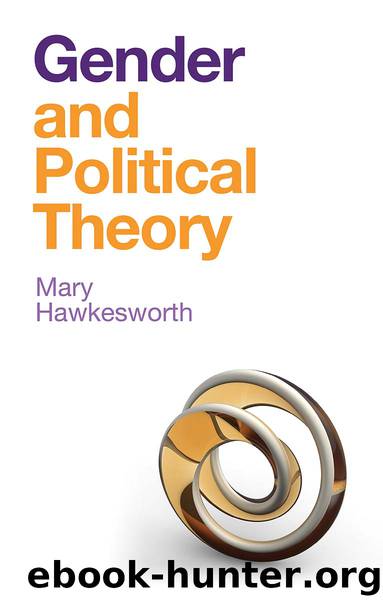Gender and Political Theory by Mary Hawkesworth;

Author:Mary Hawkesworth;
Language: eng
Format: epub
ISBN: 9781509525850
Publisher: John Wiley & Sons, Inc.
Published: 2019-02-28T00:00:00+00:00
Pornography
As a global industry that includes the mass production and circulation of texts and images in print and online, pornography is very much part of the public sphere. Yet, consumed as a form of personal entertainment, it is often discussed as a private matter. Prohibited by obscenity laws in many nations in the nineteenth and twentieth centuries, pornography has been characterized by its defenders as a victimless crime, a mode of artistic expression, and a key component of sexual freedom.
In the early 1980s, Andrea Dworkin and Catharine MacKinnon challenged this characterization of pornography as harmless and victimless by defining it narrowly as the graphically depicted and sexually explicit subordination of women. Distinguishing pornography from erotica (sexually explicit depictions of consensual, mutual sexual satisfaction) and sex education materials, Dworkin and MacKinnon argued that pornography coerces, entraps and exploits women who are involved in its production, while also disseminating the fallacious message that women enjoy sexual subordination. Pornography teaches that women take pleasure in being raped, humiliated, mutilated, and tortured. Indeed, pornography eroticizes sexual domination, conquest, violation, exploitation, possession, and use. By circulating such noxious representations, pornography reinforces women’s second-class status. As such, it should be understood as a discriminatory practice based on sex that denies women equal opportunities in society.
In the fall of 1983, at the request of the City Council of Minneapolis, Dworkin and MacKinnon drafted a civil rights ordinance to give individuals who had been harmed by pornography a right to sue for damages. The ordinance proposed to amend Minneapolis’ existing civil rights code to enable anyone who had experienced physical or economic harm through “trafficking in pornography, coercion into pornographic performances, forcing pornography on a person, or assault or physical attack due to pornography” to sue the manufacturers of the pornography for monetary compensation (Dworkin and MacKinnon 1988: 101). The logic underlying the ordinance was economic: if porn producers had to pay large settlements to those harmed by their products, they might be driven out of business. Nothing in the proposed ordinance authorized censorship prior to publication of pornographic materials. It simply gave those harmed a right to seek redress for their injuries.
The Minneapolis City Council passed the “Dworkin-MacKinnon ordinance” twice between December 1983 and July 1984, but it was vetoed by Mayor Don Fraser both times. The Indianapolis City Council passed a similar ordinance in spring 1984, but it was struck down by the federal courts as an infringement of the First Amendment guarantee of free expression. Although the court case was initiated by the American Booksellers Association and supported by the American Civil Liberties Union, there was also significant opposition to the Dworkin-MacKinnon ordinance within the feminist community. “Sex radical feminists” argued that the ordinance’s definition of pornography was “unconstitutionally vague” and would amount to a license to censor a virtually limitless number of materials, including experimentations in feminist art (Hunter and Law 1987: 108, 89, 101). Moreover, the ordinance shored up sexual stereotypes by suggesting that sex is harmful and degrading. Insisting that the ordinance
Download
This site does not store any files on its server. We only index and link to content provided by other sites. Please contact the content providers to delete copyright contents if any and email us, we'll remove relevant links or contents immediately.
On the Front Line with the Women Who Fight Back by Stacey Dooley(4702)
The Lonely City by Olivia Laing(4577)
The Rules Do Not Apply by Ariel Levy(4537)
Bluets by Maggie Nelson(4282)
The Confidence Code by Katty Kay(4049)
Three Women by Lisa Taddeo(3283)
Not a Diet Book by James Smith(3161)
Inferior by Angela Saini(3155)
A Woman Makes a Plan by Maye Musk(3147)
Confessions of a Video Vixen by Karrine Steffans(3107)
Pledged by Alexandra Robbins(3054)
Wild Words from Wild Women by Stephens Autumn(2943)
Nice Girls Don't Get the Corner Office by Lois P. Frankel(2940)
Brave by Rose McGowan(2740)
Women & Power by Mary Beard(2631)
The Girl in the Spider's Web: A Lisbeth Salander novel, continuing Stieg Larsson's Millennium Series by Lagercrantz David(2616)
Why I Am Not a Feminist by Jessa Crispin(2589)
The Clitoral Truth: The Secret World at Your Fingertips by Rebecca Chalker(2589)
Women on Top by Nancy Friday(2451)
